If you like these cartoons, please support them on Patreon
This cartoon is drawn by the awesome Leah S. Metters! Leah describes herself as “an illustrator and visual development artist working hard to create amazing books and comics so she can take over the world, one smile at a time.”
OMG, isn’t Leah’s art great? I love looking at this cartoon. It’s pretty and fun and energetic and her Thomas Jefferson’s expressions are hilarious to look at. I probably would have had Jefferson monologue for a couple more panels if I’d known in advance how much of a kick I’d get from how Leah draws him.
Yes, Jefferson really did and said all the things attributed to him in this cartoon. (Other than calling himself a rapist asshat, that is.)
There’s a good argument, I think, that – as many Jefferson apologists have said – Thomas Jefferson was, in part, a product of his time.
But only “in part.” His times can’t excuse the terrible things Jefferson did. There were contemporaries of Thomas Jefferson who understood slavery was wrong. Indeed, Jefferson himself was one of those contemporaries in his youth – although never to the extent of actually freeing his slaves.
By the end of Jefferson’s life, he was firmly pro-slavery. Obviously, many Blacks in Jefferson’s lifetime knew how evil slavery was, and Jefferson should have learned from them. There were also white abolitionists like Moses Brown (like Jefferson, a wealthy slave-owner; unlike Jefferson, he eventually freed all his slaves and was consistently anti-slavery to the end of his life.)
The main thing I mean, when I say Jefferson’s flaws were a product of his time, is that a similarly terrible person, but born in 1943 instead of 1743, would have found different ways to be terrible – maybe by being anti-civil-rights instead of pro-slavery.
Jefferson’s flaws – being a slaver, a racist, a misogynist, an abusive factory-owner, etc. – are unforgivable. (Not that he’s alive to be forgiven, anyway). But they were common flaws for a rich white man of his time. The ways Jefferson was terrible were also ways he was mediocre.
He was extraordinary in other ways, such as being a gifted writer and politician – but none of that should make us forget the ways he was mediocre and evil.
The problem is that many Americans insist that Jefferson and all the other founding fathers were extraordinary, not just for their political or military successes, but for their wisdom and morality. And when it comes to wisdom and morality, most founding fathers were, at best, mediocre, and sometimes much worse.
This cartoon is less about Jefferson, than it is about how ridiculous it is that anyone today venerates Jefferson for wisdom or morality.
TRANSCRIPT OF CARTOON
This cartoon has four panels.
PANEL 1
Two children, a boy with huge glasses and a backpack, and a girl with her hair in a puff pony and wearing a colorful striped shirt, are in a park full of lush greenery. They’ve stopped by a wooden park bench; seated on the bench, wearing an early-1800s style suit and a peruke (which is what the white wigs most founding fathers wore were called), is the ghost of Thomas Jefferson. We know he’s a ghost because he’s a glowing pale blue color, he’s a little transparent, and he sort of twirls out of existence below the waist rather than having legs.
The boy and girl look enthusiastic; Jefferson seems quietly flattered.
BOY: It’s the ghost of Thomas Jefferson!
GIRL: The founding fathers were moral and intellectual giants! Share your wisdom with us, President Jefferson?
JEFFERSON: Very well.
PANEL 2
A close-up of Jefferson. He looks a little wide-eyed and intense, and his gesturing with his hands to emphasize his points.
JEFFERSON: To get rich, run a nail factory, and whip workers who make less than 5,000 nails a day. Children too!
JEFFERSON: And as I told my friends, invest every dollar you have in slaves!
PANEL 3
Another one-shot of Jefferson. He’s now looking more thoughtful, smiling a little with a finger pressed against his chin.
JEFFERSON: Orangutans are more attracted to black women than to other orangutans. That’s just science!
JEFFERSON: Let’s see, what other founder wisdom can I share?
PANEL 4
A shot of the three of them. The two kids look pissed; Jefferson concedes cheerfully.
GIRL: Actually, we’ve changed our minds about caring what you thought.
JEFFERSON: Solid choice! I was a slave-owning rapist asshat.

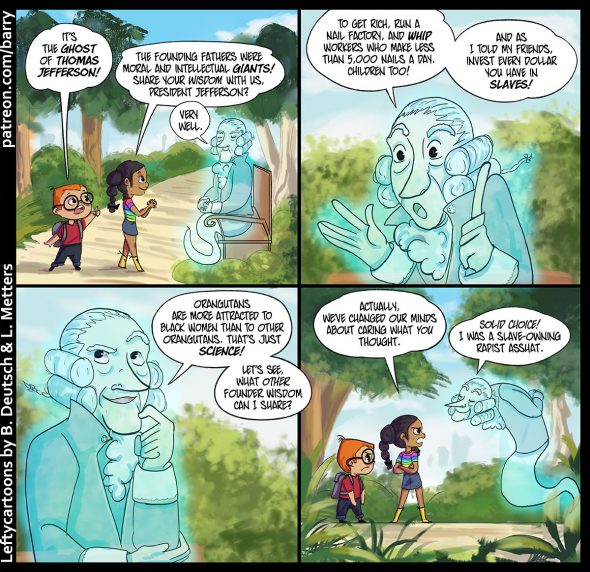
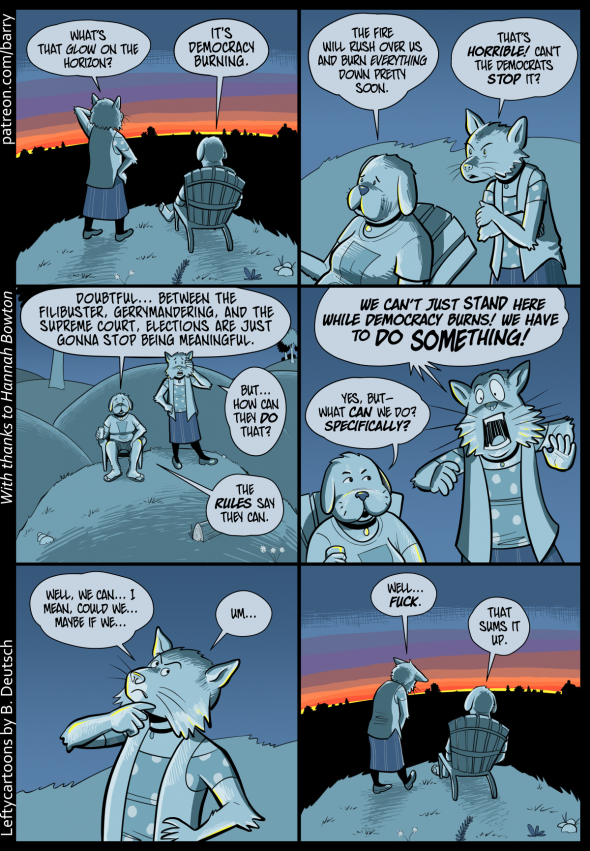




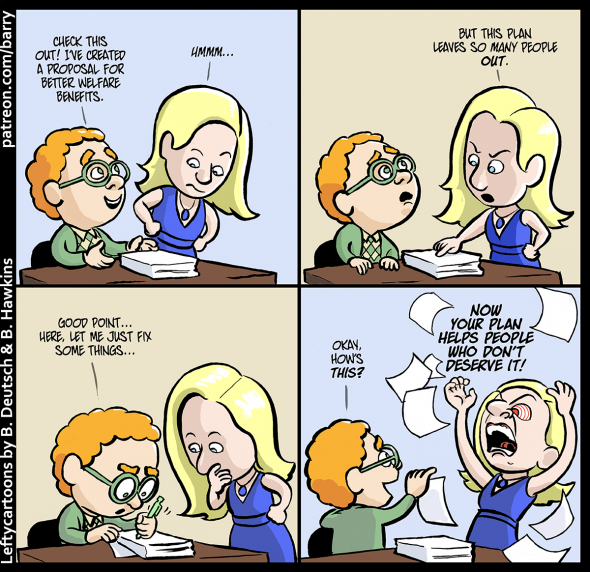
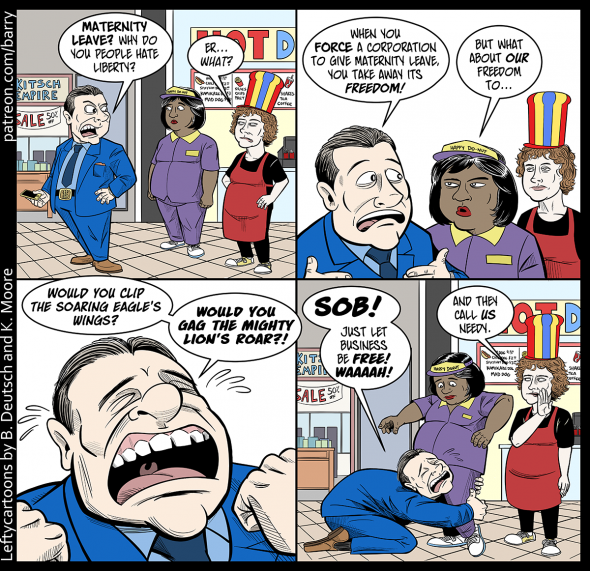

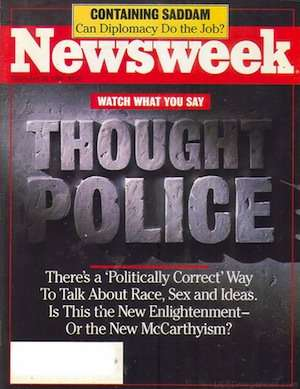 I remember first hearing the phrase “political correctness” in the late 1980s. At first it was a tongue-in-cheek term lefties used to make fun of our more over-the-top comrades, and of ourselves. But the right grabbed on to it and it became the menace that’s taking over the youth.
I remember first hearing the phrase “political correctness” in the late 1980s. At first it was a tongue-in-cheek term lefties used to make fun of our more over-the-top comrades, and of ourselves. But the right grabbed on to it and it became the menace that’s taking over the youth. 
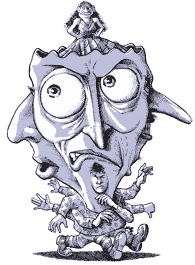
Also unrelated to the point of the comic, I keep thinking the "we deliver" character is Jughead Jones.